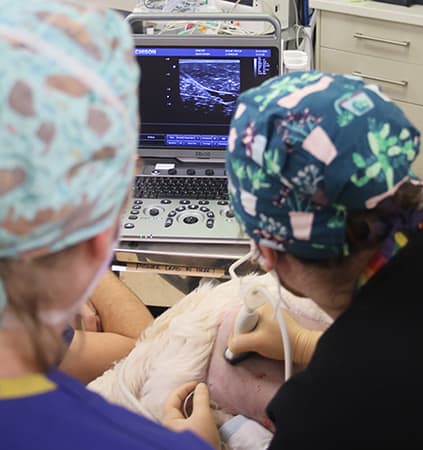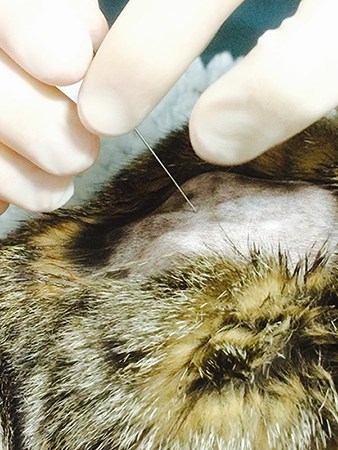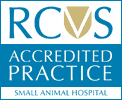 If your pet requires a surgical procedure with us at Cave Veterinary Specialists, our anaesthetists may use a local anaesthetic as part of the anaesthetic plan.
If your pet requires a surgical procedure with us at Cave Veterinary Specialists, our anaesthetists may use a local anaesthetic as part of the anaesthetic plan.
Surgery can lead to short-term discomfort and one of the best ways to minimise this is by using local anaesthetics.
Local anaesthetics ‘numb’ the area meaning that your pet cannot feel what is happening. These techniques can be used both during and after surgery, meaning your pet has a comfortable stay with us.
What is pain?
The feeling of pain starts with a stimulus, in this example the surgical incision. This stimulus is passed along nerves to the spinal cord, and then along the spinal cord to the brain. The brain recognises the painful stimulus, and in an awake animal sends a signal to move away from the source of pain.
How do local anaesthetics work?
Local anaesthetics stop this pain signal from reaching the brain, so your pet will not ‘feel’ the painful stimulus.
The area below the local anaesthetic becomes numb, and with some techniques, your pet may not be able to use their legs for a short period of time. If this is the case, we ensure they have a comfortable bed and are assisted to eat, drink and go to the toilet until they are able to walk freely again.
What is the advantage of using a local anaesthetic?
The main advantage of local anaesthetics is that your pet cannot feel the surgical site, but there are other advantages:
- Reduced need for ‘strong’ painkillers after surgery
- Reduced anaesthetic requirement during surgery
- Faster return to eating after surgery
- Overall reduced cost of anaesthesia
How do you do these local anaesthetic techniques?
Depending on the type of surgery your pet is having, and any other conditions they may have will depend which local anaesthetic technique the anaesthetist chooses.
- Epidural; this involves injecting local anaesthetic around the spinal cord, it is particularly good for hind limb, abdominal and some thoracic surgeries
- Epidural catheters; this involves threading a very narrow catheter into the epidural space, it can be used before, during, and after surgery to give your pet the highest level of pain relief.
They require careful monitoring, with our registered ward nurses always on hand to watch your pet after surgery:
- Limbs; The entire limb can be ‘numbed’ by injecting local anaesthetic close to the large nerves at the top of the leg, this is good for surgery involving joints or broken bones
- The head and jaw; areas of the head and jaw can be desensitised if facial, dental or jaw surgery is required
- Infiltrations; local anaesthetic can be injected around the surgery site; this is good for smaller areas like toes or small lumps. We can also inject local anaesthetics via a catheter to numb the surgical site postoperatively, this will differ with each surgery that is performed.
The anaesthetists use advanced techniques such as peripheral nerve stimulation and ultrasound guidance to ensure that the local anaesthetic is injected around the nerve and to reduce the risk of complications.
What are the risks of local anaesthetics?
The risk of local anaesthetics is very small and the anaesthetists do everything they can to minimise this risk to your pet. However, the risks from local anaesthetics include:
- Failure to ‘numb’ the surgery site effectively. In this case, additional painkillers will be provided via another method to ensure that your pet doesn’t feel any pain.
- The block can sometimes last longer than expected, and your pet may need assistance to stand for a few hours after surgery
- Infection at the site of injection can occur
- Longer-lasting nerve damage can occur
We do everything we can to minimise these risks but if you have any concerns or questions, please ask to speak to one of our anaesthetists who are always happy to talk through any local anaesthetic technique your pet may be having
Will it take a long time to perform?
Our anaesthetists have undergone advanced training in these techniques and perform them frequently. A small additional amount of time will be required to inject the local anaesthetic, but this is short and will not have a negative effect on your pet.
Summary
Local anaesthetics are a valuable part of our anaesthetic plans, and our anaesthetists use advanced techniques to minimise any risks to your pet. They are one of the best ways we can provide pain relief for any pet having surgery. If you have any questions please ask your consulting vet if you can speak to one of the anaesthetists, who would be happy to discuss your pet’s local anaesthetic technique with you. Cave Veterinary Specialists




